High in Beijing’s sky, the August sun glows red by midafternoon, a star struggling to illuminate China’s crowded capital from above the dust and pollution.
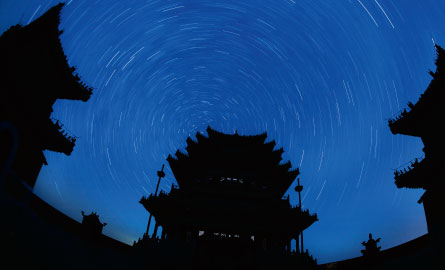
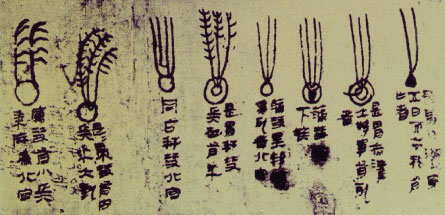
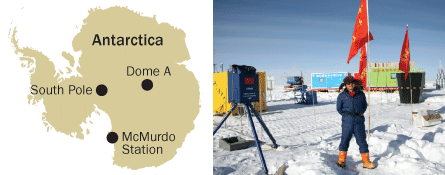
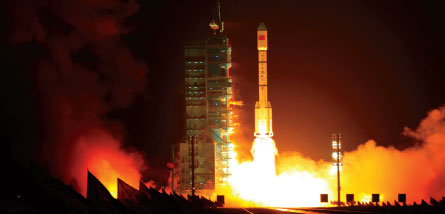
I’m in the city along with 3,200 astronomers for the International Astronomical Union’s two-week General Assembly meeting. It’s the first time the IAU has convened the assembly in China, an important milestone for a country attempting to reclaim its former astronomical significance.
Tradition and modernity squeeze together here, like the cars that navigate the congested streets. A recently expanded subway system zips below the remaining hutongs, narrow alleyways surrounded by stone houses that once formed the nuclei of the city’s neighborhoods. Chang’an Avenue’s 12 lanes slice through Beijing’s heart, right in front of the Forbidden City’s sprawling maze of ornate palaces and colorful temples bejeweled with the sacred symbols of a bygone era.
Like Beijing, Chinese astronomy is at once ultramodern and steeped in the traditions of millennia. For thousands of years, it developed independently from the West, with astronomers watching the shifting skies and inventing instruments to chart the heavens and keep track of time. But after many, many years, the country’s intellectual prosperity came to an end.
In 1966, Mao Zedong’s regime plunged China into its Cultural Revolution. The decade-long period of turmoil sealed the country’s people from the outside world, incubating policies that would leave lasting scars. Among the many casualties were science and innovation — and China is still struggling to recover from the void in expertise left behind.
“At present, there is still a big gap between Chinese astronomy and Western advanced countries,” says Fang Cheng, a solar astronomer at Nanjing University, northwest of Shanghai. “We have not many large facilities for the astronomy observations.”
That’s changing, though. Driven by historical, ideological and emotional concerns for greatness, the same political system that had hamstrung Chinese science has been working for two decades to revive it. Bolstered by a growing budget, Chinese astronomy is aiming to unleash a torrent of discoveries in the coming years. World-class telescopes and observatories are making their debut within the country, at the Dome A station in Antarctica and in space. China is in a race to regain its place of prominence in the pantheon of stargazers.
Journey to the past
Along Chang’an Avenue, just east of Tiananmen Square, sit relics of China’s astronomical past. Exit the Jianguomen subway station, take a right and look skyward.
Eight astronomical instruments, each hundreds of years old, are poised like sentinels atop an observing platform. Though easy to miss amid the city’s hustle-bustle, these bronze, sculpted instruments mark the spot where an observatory once flourished. For centuries Beijing’s Ancient Observatory, completed in 1442 during the Ming Dynasty, served as an epicenter for astronomers mapping the stars.
But astronomy in China has much deeper roots. As early as 2400 B.C., Chinese astronomers were charting the heavens. A calendar made at that time used the location of the star Antares to mark the beginning of a year. Four hundred years later, astronomers timed solstices and equinoxes based on Antares and three other stars, an effort described in the Chinese Book of Documents’ Canon of Yao. Between 1523 B.C. and the end of the Qing Dynasty, in A.D. 1911, Chinese astronomers recorded more than 4,000 comets and more than 1,000 solar eclipses. Ancient records of sunspots are still studied by modern astronomers tracking the solar cycle, says Fang, who also lectures on the history of Chinese astronomy.
Sky-gazers also recorded more than 90 exploding stars in texts between around 1700 B.C. and A.D. 1600. The most famous, perhaps, is a supernova that occurred in 1054, creating what’s now called the Crab Nebula. Several Chinese observations of the 1054 supernova exist, including a description in a history of the Song Dynasty that locates the explosion: “A guest star emerged several [inches] south-east of Tianguan. After more than a year it gradually disappeared.”
The Chinese are very polite, Fang says. “They called the exploding stars ‘guest stars.’ ”
In the 13th century, Guo Shoujing invented a collection of sky-mapping instruments, including the simplified armilla — a version of which can be found at the Ancient Observatory. Later, Guo used his instruments to precisely determine the length of a year at 365.2425 days. He then drew up a calendar that served imperial courts for centuries, until the Renaissance brought Jesuit missionaries to China. “At that time, China began to realize that we have to learn much from the Western countries, including the astronomical field,” Fang says.
Signs of Western influence still linger at the Ancient Observatory, where the Flemish Jesuit missionary Ferdinand Verbiest served as director in the 17th century. Verbiest designed some of the instruments visible from the subway station: A quadrant from 1673, which can measure celestial altitudes, is festooned with dragons. Nearby, an altazimuth — used to determine celestial angles — sits next to an armillary sphere and a detailed celestial globe. And there is a sextant, a larger and more ornate version of the instruments sailors used to navigate the seas.
In the early 20th century, Chinese astronomy began building its modern foundations. Early bricks were set with the birth of the Chinese Astronomical Society in 1922. Then, in 1934, China founded the Purple Mountain Observatory, based in Nanjing. The next year, China joined the International Astronomical Union.
Soon after, though, astronomy in China came to a violent halt. The defeat of the Kuomintang in 1949 brought Mao Zedong into power. In an attempt to transform China from an agrarian society into an industrialized collective, Mao instituted the Great Leap Forward. Food production slowed, the economy stalled and, by 1961, much of China was in ruins. Needing to regain credibility and power, Mao in 1966 ignited the Cultural Revolution, erasing much of China’s historical record and isolating the country from the rest of the world.
Threatened by new ideas, the government dismantled the scientific establishment, targeting intellectuals, educators and scientists. Many were sent to work on farms or in factories. Schools closed. “At that time, the whole system was a mess,” says political scientist Richard Suttmeier, professor emeritus at the University of Oregon in Eugene. When the revolution officially ended in 1976, a generation had been denied proper education and scientific expertise had been lost.
Burning bright
Hoping to repair the damage and become an international leader in science and technology, the Chinese government is now investing heavily in astronomical projects, within the country and internationally, as well as in science education. “It’s a recent development,” says Cong Cao, a sociologist at the University of Nottingham in England who studies science and technology in China. “It most likely happened at the same time the Chinese economy started to take off.”
In 2009, research and development expenditures in China amounted to 580 billion Chinese yuan (about 150 billion U.S. dollars, when adjusted for purchasing power), according to an analysis by the Organization for Economic Cooperation and Development. That figure was roughly 1.7 percent of the country’s gross domestic product. By 2020, China hopes to be spending 2.5 percent of its GDP on research and development, which would put it nearer the United States, where R&D spending in 2009 amounted to 2.9 percent of GDP. (Both nations lag behind Japan, which spent 3.4 percent of its GDP on R&D in 2009.)
It’s hard to know how much of that money is going toward basic research in astronomy. Fang estimates that total government funding for such research in 2012 is around 200 million yuan, up from less than 20 million yuan a decade ago.
Vice president Xi Jinping, one of the Communist Party’s highest ranking officials, emphasized the country’s commitment to astronomy at the IAU meeting’s opening ceremony in Beijing. “Astronomy, as the science to explore the universe, is one of the most important and the most active scientific frontiers,” said Xi, the presumptive next president of China. “To explore this vast universe is the common goal of all humankind; astronomy in fast development is the shared fortune of all humankind.”
Xi’s speech “was a clear indication that Chinese leaders realize the importance of elevating the role of science in education and economic development,” says Robert Williams, an astronomer at the Space Telescope Science Institute in Baltimore and former president of the IAU.
About 160 kilometers northeast of Beijing is a tangible sign of Xi’s statements — the Xinglong Observing Station, which hosts China’s largest telescope. The station belongs to the National Astronomical Observatories of China and is in the Yanshan Mountains, the same range as the most tourist-soaked sections of China’s Great Wall.
At 8 a.m. on a Saturday, I head for the hills with a dozen or so astronomers. Highways so gridlocked that drivers step out of their cars for a leisurely cigarette slowly transform into flower-lined roads curving through villages and rounded, limestone mountains that appear to bubble up from the Earth.
Nearly three hours in, I spot the observatory sparkling atop a distant ridge. Domes protruding from the hills resemble a line of bread crumbs leading to Chinese astronomy’s most treasured gem: A new, futuristic-looking telescope known as LAMOST, short for Large Sky Area Multi-Object Fiber Spectroscopic Telescope. Also called the Guo Shoujing Telescope, the instrument has two parts: a classically shaped dome and a detached tunnel rising up from it at an angle. A chance to scramble around inside the telescope’s guts reveals the honeycombed mirrors that bounce light back and forth, and the knotted electronic nerve center that processes incoming photons.
Completed in October 2008, at a price tag of 235 million yuan, the 4-meter telescope is considered a National Major Scientific Project. Now the largest optical telescope in China, it dethroned the 2.16-meter reflector that lives in the next dome over.
For the last few years, scientists have been troubleshooting LAMOST and conducting pilot surveys. Once science observations are under way, LAMOST will point toward the star-splashed center of the Milky Way, uncovering clues to the galaxy’s structure and evolution. Over an observing period of five years, astronomers plan to study more than 10 million stars and millions of distant galaxies.
LAMOST is just one prong in China’s all-out astronomical assault.
In the south, researchers are installing what will be the world’s largest radio telescope. When complete, the dish — called FAST for Five-Hundred-Meter Aperture Spherical Radio Telescope — will be almost 200 meters wider than the 305-meter telescope near Arecibo, Puerto Rico. Nestled into a depression in the karstic terrain of Guizhou Province, and coming in at a cost of about 700 million yuan, FAST should see first light in 2016, says astronomer and project chief scientist Nan Rendong of China’s National Astronomical Observatories.
Because of its extreme sensitivity, the telescope’s impact on astronomy will be enormous, Nan says. “Its unique contributions to science may not yet be predictable.” Observation targets include pulsars, interstellar molecules and distant, gassy galaxies. It might also listen for signs of intelligent extraterrestrial life.
As China develops facilities across the mainland, it is also expanding to the Antarctic. Already, the country has a few scopes on the icy ground at Dome A. At 4,000 meters elevation, the site is the highest point on the continent’s plateau. Clear, dry air and four months of wintry darkness make Antarctica an ideal observing site, says astronomer Lifan Wang, director of the Chinese Center for Antarctic Astronomy and a professor at Texas A&M University in College Station. “To have an observatory in that place, I’m thrilled,” Wang says. “It’s like an outpost on a planet that’s not Earth.”
Debuting by 2015 will be the Antarctic Survey Telescope, a trio of eyes that will stare at the sky, waiting for stars to explode, observing galactic nuclei and looking for exoplanets. Wang has studied supernovas for decades, and was a member of one of the teams that in the 1990s used them to determine that the expansion of the universe is accelerating.
A trial run had the first of three scopes staring at the galactic center and the Large Magellanic Cloud earlier this year. The second eye will be installed next year, and the third in 2014, Wang says.
Farther afield still will be the Hard X-ray Modulation Telescope, China’s first astronomy satellite. Tasked with observing black holes, the Earth-orbiting scope could launch as early as 2014, Su Dingqiang, an astronomer and member of the Chinese Academy of Sciences, said at the IAU opening ceremony. Additional orbiters are planned for the coming decade, including solar observatories and a dark matter probe. These instruments will be joined by China’s space station, set for completion in 2020. Though expected to be smaller than the International Space Station, China’s version should be operational by the time the ISS is retired into the Pacific Ocean.
In Chinese astronomy’s broad reach, the solar system’s planets and other residents could be the targets that are missed, Williams says. A lunar lander is tentatively on the schedule, but most of the country’s off-planet endeavors are aimed toward human spaceflight and the new space station. In 2003, China became the third country to independently send people to space, and orbital rendezvous are currently being demonstrated with the test module Tiangong-1.
Still, Williams says, China has been intelligent with its investments, paying attention to different disciplines, joining international collaborations and creating training opportunities. “They are putting much effort into developing young scientists, which is really the key to their future,” he says.
The human factor
To translate first-class facilities into first-rate science, China will need to overcome the policies that left a void in its science community. “There’s no doubt that something big is happening in China with science and technology,” Suttmeier says. “But the problems are also enormous.”
As a result of the Cultural Revolution, China’s existing stable of astronomers is relatively young and inexperienced. And the country’s educational system isn’t set up to foster the kind of creative thinking that leads to innovation. “In the process of your education, you have been taught to do whatever you’re asked to do,” Cao says. That means memorizing facts, passing tests and obeying your professor.
What’s more, many of China’s best minds end up leaving the country to work or study overseas. China is coming up with ways to combat this brain drain, which has seen at least a million of China’s people seek foreign education since 1978. In 2008, the country established the Thousand Talent program, designed to attract 2,000 scholars back to China over the next several years.
At the same time, China is trying to become a magnet for scientists and scholars from afar, which Suttmeier says will be crucial for success. In 2011, the government announced the Thousand Foreign Experts project, which aims to attract 1,000 foreign scientists to China over the next decade. But one problem with such schemes is the limited career advancement opportunities for foreigners in China. “As long as the Communist Party is running China, it’s hard to imagine foreigners who are not party members taking critical positions in research institutions,” Suttmeier says.
While Chinese astronomers frequently collaborate with scientists from many nations, including Australia, the United States and those in Europe, some relationships can present challenges.
Currently, many U.S. government-funded scientists aren’t allowed to participate in one-on-one collaborations with the Chinese. In 2011, Congressman Frank Wolf inserted language into an appropriations bill prohibiting researchers at some agencies from working bilaterally with the Chinese. When the White House Office of Science and Technology Policy ignored the prohibition, Congress cut its 2012 budget by 32 percent.
Asked about how the restriction is affecting collaborations with Chinese astronomers, officials at NASA declined to comment, but did say that Public Law 112-55 prohibits NASA from engaging in bilateral collaborations with China.
“They are so intimidated by this language,” says Joan Johnson-Freese, who studies the intersection of space policy and national security at the U.S. Naval War College in Newport, R.I. “Nobody wants to test that. There is fear — and I use that word, and you can quote me on that — there is fear of being in a room with a Chinese researcher if you’re from NASA.”
So although China is laying a new foundation with instruments and trying to glue its bricks together with training programs, a lot of work remains. “I don’t think in the near future we can play a leading role in the world,” Fang says. “Probably after many years, then we can catch up.”
Still, efforts that require many years elsewhere often happen quickly in China. All but two of the Beijing subway’s 15 lines were built in the last decade. The Great Hall of the People, built to celebrate the country’s 1959 anniversary, was erected in just 10 months. And in preparation for the 2008 Olympics, China constructed the enormous, ultramodern Terminal 3 at the Beijing airport, reportedly in four years.
Leaving China through that Olympic terminal, I notice a replica of one of the instruments in the courtyard at the Beijing Ancient Observatory. Four green-hued, spiky-spined and sharp-clawed dragons work together to hold aloft a gigantic sphere. The sphere’s skeleton seems exposed, with giant bands of metal curving around the empty space at its heart. It is based on an armillary sphere that dates back to 1439.
Here, set amid one of the busiest gateways to the outside world, travelers pause for pictures with a symbol of China’s astronomical past.
Blending the old and the new
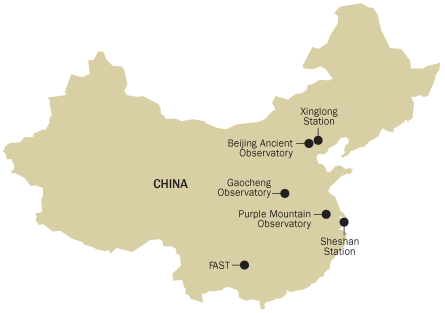
Map: Geoatlas/Graphi-Ogre, Adapted by T. Dubé
China’s astronomical past is alive at ancient observatories that served as centers of learning and culture for centuries. But the country is now working hard to catch up with a more modern global astronomy community. Chinese scientists hope new facilities will help their country reclaim its astronomical renown.
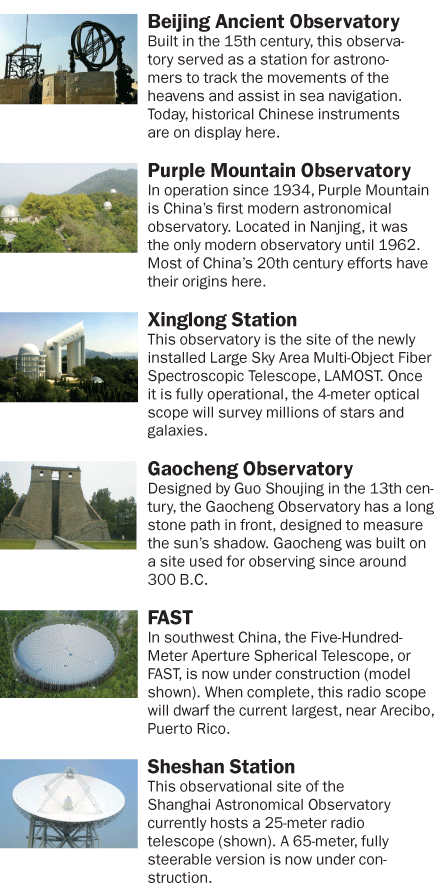 Images, from top: N. Drake; Julius Rabl/Wikimedia Commons; N. Drake; Takwing.Kwong/Wikimedia Commons; R. Nan et al/Int. J. Mod. Phys. D; © Imaginechina/Corbis
Images, from top: N. Drake; Julius Rabl/Wikimedia Commons; N. Drake; Takwing.Kwong/Wikimedia Commons; R. Nan et al/Int. J. Mod. Phys. D; © Imaginechina/Corbis
Ideological run-in
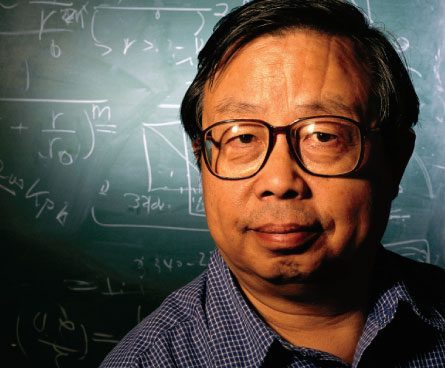
Popular Science via Getty Images
Political ideology and science clashed throughout the life of Fang Lizhi, one of China’s most famous astrophysicists.
Fang, born in 1936 to a working-class family in Beijing, was initially interested in physics. As one of the most brilliant minds of his generation, he studied at Beijing University and became involved in an early attempt to develop nuclear weapons in China. But by the late 1950s, he had fallen out of favor with the rising Communist Party, because of an essay criticizing political intervention in scientific discourse.
When the Cultural Revolution struck, Fang was one of many academics targeted. He was sent to work in a coal mine in 1967. But he managed to hold onto an astrophysics textbook and teach himself cosmology. After some time in a brick factory, Fang returned to academia. In the early 1970s, he published the first modern cosmological paper in China, about the Big Bang and a finite universe. The Communist Party objected again. (Marxist philosophy espoused an infinite universe.)
For almost two decades, an uneasy truce allowed Fang to stay in the country, though he was expelled from the Communist Party when his political activity helped spark student demonstrations. Following the Tiananmen Square protests, Fang sought asylum in the West. He eventually settled in the United States, where he would remain, studying astrophysics and cosmology at the University of Arizona until his death earlier this year.







